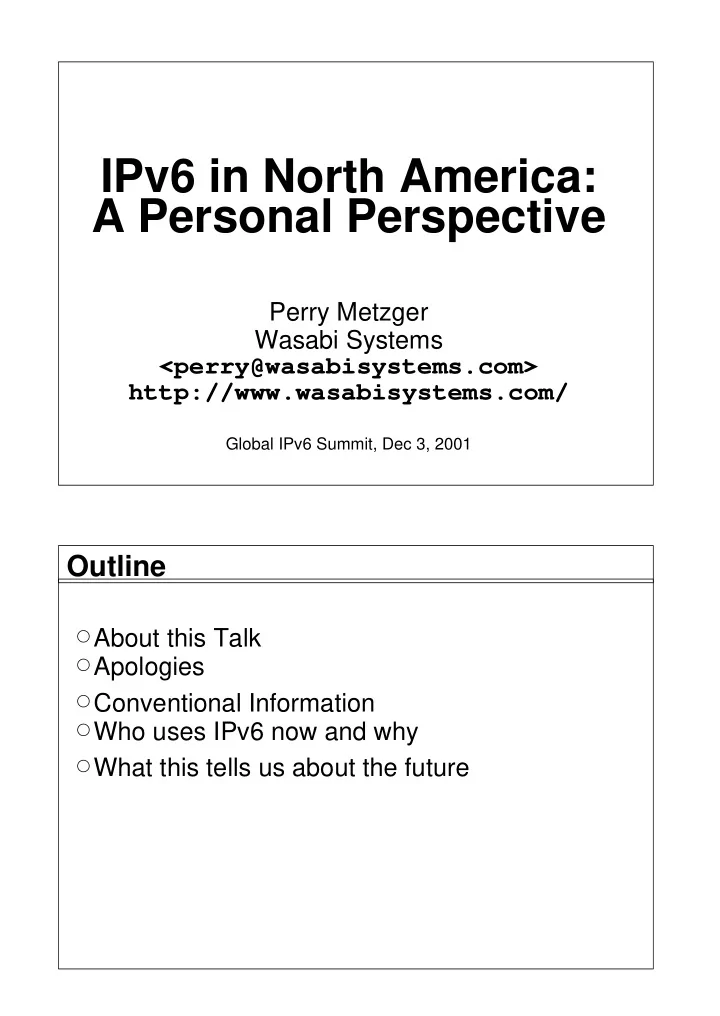

IPv6 in North America: A Personal Perspective Perry Metzger Wasabi Systems <perry@wasabisystems.com> http://www.wasabisystems.com/ Global IPv6 Summit, Dec 3, 2001 Outline About this Talk Apologies Conventional Information Who uses IPv6 now and why What this tells us about the future
About this talk... This is not a quantitative status report. I will not be presenting graphs. (Help me make sure we have them next time.) This is my personal perspective on where development and deployment are now in North America, and where they are going in the near future. IPv6 is not "National" It is hard to discuss just North America. I use IPv6 every day. Most of my network traffic goes over IPv6. My TCP/IPv6 stack was written by KAME in Japan. My O.S. was written around the world. My company has employees in three continents and five time zones. (My company phone bills are huge.) ...so my perspective is not just "North American". Much of what I say applies worldwide.
Conventional information Network Equipment Support End Systems Support Provider Support Big N.A. Router Manufacturers Cisco IOS 12.2(2)T and newer Juniper JUNOS 5.1 (as of Nov 28, 2001) Supports routing ASICs, all M series routers! Nortel BayRS supports v6
Big N.A. Systems Companies Apple OS X IPv6 (Developer Kits only) Compaq Tru64 UNIX V5.1 (kernel, most of userland) IBM AIX has full v6 Microsoft v6 in XP (though you have to turn it on) Sun Microsystems Solaris 2.8 (kernel & every app) HP HP-UX 11i Conclusion: Hardware/Software is nearly done. This is a worldwide trend. IPv6 integration into systems software and routers is now very advanced. (It isn’t all done but it is starting to get close.) The open source community has also nearly finished integration. You no longer need to be a fanatic to use IPv6 every day. It is becoming very easy.
Experimental Deployment Work Peering Points PAIX 6TAP Peering point Joint project of Canarie and ESnet Others Experimental Deployment Work Tunnel Brokers FREENET6 Tunnel Service Service of Viagenie Hurricane Electric Tunnel Broker BT/Microsoft Research Tunnel Broker Many "Informal" Services 6to4 relay routers Microsoft Research Cisco
Providers are lagging No North American providers are currently offering native IPv6 service to real customers. Informal observation says usage is rapidly increasing, but almost all users are interconnected over tunnels -- either "traditional" or now 6to4 based. Provider interest seems much lower than customer interest! Providers are not yet important. We used to think providers would start deploying quickly and that tunnels were temporary. Providers have not stepped in, but tunnels are everywhere, and people are doing okay with them. People seem to be planning on tunnel based services for the long haul. 6to4 is an example of this strategy.
Barriers to usage have fallen... Two years ago, even most IETF IPv6 Working Group members did not use IPv6! Very few people were "every day" users. It was too difficult. There was no integrated software. There was no hardware. That has completely changed! You can now use IPv6 every day for most of your work. Usage is rising fast Number of AAAA records is rising quickly. "Unintentional" usage happens constantly. Operations problems are noticed fast. Bugs in v6 enabled programs are noticed.
How much deployment is out there? We don’t know. Finding out is important. Join me in figuring out. New mailing list: metrics@ipv6.org (Subscribe via majordomo@ipv6.org) IETF Mailing List Criticism: In a recent discussion, several people said: "Who cares if people are using it. The ISO stack was also used by a couple of people." My answer: "People are starting to use v6 to fix real problems for themselves, and the number of users is exploding. It was under twenty a few years ago and now we need as measurement project."
Who is using IPv6 Currently? Computer Professionals/Hackers. "Informal" users. A few test environments. Currently, the computer professional/hacker community is the most important group of early adopters. They have the needed software, can deal with problems, and have keen interest. My Rule of Technology Prediction "Look at what the hackers are using. Everyone else will want that in a few years." The Internet Personal Computers Wireless LANs Digital Music Compression/Storage and now... IPv6
What are the informal users doing? Why are they deploying v6? They need to get past NATs. IPv6 gives them a "real internet" again. Do they care about native v6 providers? They would like them ... but they don’t need them. Tunnels work fine for now. Typical Example: graphic: INSERT PROBLEM GRAPHIC
Typical Example: graphic: INSERT THREE TUNNEL GRAPHIC Newer example: INSERT MULTIPLE ROUTED TUNNELS GRAPHIC
Extrapolation 1: "NAT-busting" is a big application for the future. NATs ruin many apps. Nested NATs are expensive and unreliable. Big companies spend lots of money dealing with them. Even little organizations are hurt. Easy solution: use IPv6 overlay networks. Predictions: Network management Nested NATed Nets are difficult to manage. Overlay networks are much simpler. Easy opportunity for network management vendors. Inter-corporate apps Typically proprietary software Protocols implemented in house NATs, etc. make delivery a nightmare. Deliver over v6 instead
The Killer App So what is the killer app for IPv6? THE INTERNET! End to End Communications, Anytime, Anywhere. The Road is Long Deployment: marathon, not sprint. Equipment replacement cyles are long. Training takes a long time.
We’ve come very far. Two years ago, I had never sent an IPv6 packet. Six months ago, I was visiting a friend at a University in New York. I turned on my laptop to use the wireless network, and it did an ND request as always. Suddenly, I had an IPv6 address. The world is changing rapidly. IPv6 in North America: A Personal Perspective Perry Metzger Wasabi Systems <perry@wasabisystems.com> http://www.wasabisystems.com/ Global IPv6 Summit, Dec 3, 2001
Recommend
More recommend